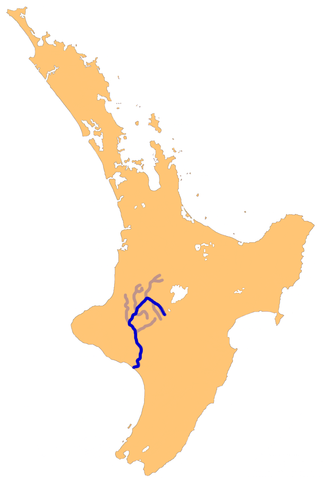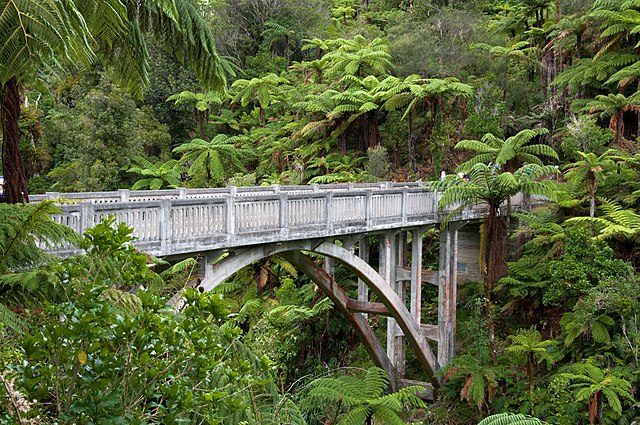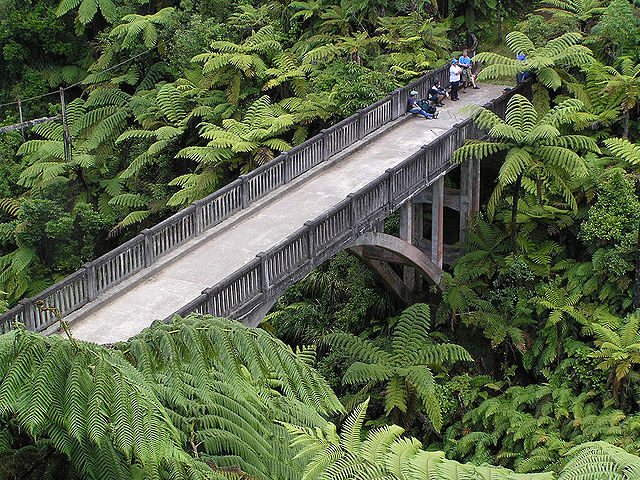This simple concrete road bridge over Mangapurua Stream in New Zealand is located far away from civilization and literally in the middle of nowhere, nestled in the heart of the dense forest of Whanganui National Park. At first it seems that the story behind it is quite absurd: once upon a time an eccentric rich person had some extra money, a lot of free time, and a strange sense of humor, and decided to build a bridge without any purpose, nor practical function, in the most remote location in the world.
However the actual story is different. Although there are neither roads nor any visible traces of permanent human habitation around the bridge, in the past this isolated area deep in the forest was carefully planned and constructed for a community. As a matter of fact, it was inhabited, but only for a brief period.

The story of the bridge begins approximately one hundred years ago. During World War I, New Zealand’s government decided to develop less populated places because land and resources around existing settlements were running out. The Mangapurua and Kaiwhakauka valleys, located in the western part of North Island, were chosen as part of this large soldier settlement project. Farms were provided in these areas for soldiers returning from the war as a reward for their service.
The first settlers came in 1917. Soon over 40 families took parcels of land and started to live there; 30 farms existed in Mangapurua and 16 in Kaiwhakauka. Although life in the remote area turned out to be difficult from the start, the first steps were very promising: 1,100 acres of land was cleared of vegetation in order to make space for farmland.

The community thrived mostly because of the strong bonds between the settlers. They shared similar war experiences, and in the new circumstances they fought like loyal brothers in arms. The settlers used river steamers on the Whanganui River for the supply of goods, and construction of a road line was started which was supposed to provide better connection of the settlement with the river.
But the promises of the authorities year by year were fading away. New Zealand’s postwar recovery did not go according to plan and suffered serious setbacks; in 1921 the families in remote areas were left to fend for themselves. One by one they were moving away from the valley.

In 1926 a school was opened in an abandoned house to support the community. But it didn’t solve the acute problem — the economic crisis was only a small piece of the mosaic. The rains caused many floods and heavy soil erosion which often damaged the structures, which jeopardized these communities only connection to the outside world.

At first, in 1919, a simple and flexible wooden swing bridge that could carry horses was built. It was the only access to the valley and the new settlement. The wooden bridge was very unstable and after many years of constant agitation from the locals, a more stable steel-reinforced concrete road bridge was built in 1936. But it was used for no more than six years: the inhabitants of the Mangapurua Valley Soldiers Settlement finally lost the battle to keep the bridge open.
During heavy rain in 1942, rocks crashed onto the road because of serious erosion that had been caused by the clearing of vegetation. The last three families were forced to leave their homes because the government decided that the road could no longer be maintained. The authorities paid them a very small amount of compensation that could not replace their loss — the place was completely abandoned in 1944. Further construction of the road to the Whanganui River was stopped and during the following years, the bridge was almost never used.

The Mangapurua Valley community had struggled for years with the valley’s poor and infertile soil, with the invasive vegetation which continued to grow and regrow. After the abandonment of the settlement the forest grew back completely, erasing almost all of the signs of human habitation, except the bridge. Soon the place became known as “the valley of abandoned dreams.”

Until 1986, trappers and hunters had the valley to themselves. That year the government incorporated it into the new Whanganui National Park, and in 1995 the bridge was repaired and now serves as one of the park’s attractions. The Mangapurua Landing can be approached by jet-boat tours and then by foot through the magnificent native forest. Interestingly, the bridge is busier than in the past and it has become an emblem of the human struggle to survive in the wilderness. The “Bridge to Nowhere,” the vanishing road line, a few old fences, and some ruined brick chimneys are all that remain of the old settlement.
